No Walls and the Recurring Dream by Ani di Franco
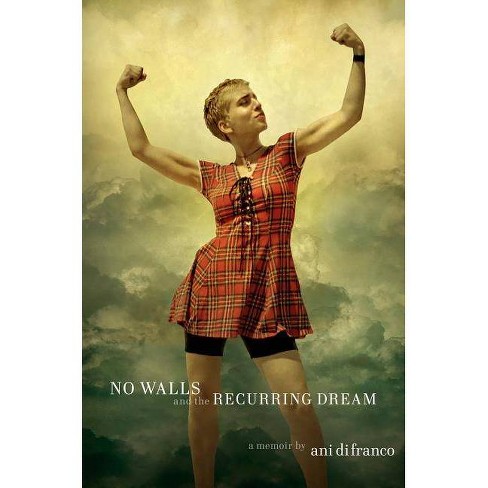
Ani di Franco flexes her deep feminist thinking here in a book that’s part storytelling, part philosophy, part rant. It’s also a feminist coming of age story: ‘I knew it right away; I am part of a feminist continuum…The political radical that I was born to be was finding context, changing shape…becoming female.’
Ani di Franco covers so much ground in this book that it’s hard to capture the diversity of her gaze. This includes her thinking about binary systems in nature that have infinite potential and gender as a spectrum, and her friendship with the folk singer and historian Utah Phillips (“he made it his gig to sow the seeds of critical thinking and he did so through a street-level awareness of history and oral tradition”). Then there’s her take on Bob Dylan, her musings on the melody of prose, her commitment to confront inequalities and to support global diversity, and her advocacy for women’s leadership including cultural leadership. For instance, this:
I have searched high and low for women to tour with in every single job position…. there are simply too few women in the music biz in general, at least on the touring side. Not just female musicians playing instruments, but also sound engineers and techs and roadies of all stripes. On the tech and roadie side, there are also way too few people of color.
When I grow up, I am going to start a school for sound engineers, lighting designers, production managers, stage managers, and all other crew-related jobs, aimed at the diversification of the means of music from the ground up…
Still, the degree to which we continue with the paradigm of men as doers and women as bearers is up to us.
Her vision is big, and much needed at this time, so this is a book for the here and now:
Who among us will dare now to dream? For me: The Reproductive Freedom Amendment. The abolition of the Electoral College. The revamp of the electoral system, the criminal justice system, the health care and education systems. The dawning of sustainability through conservation and biomimicry. Prioritizing and incentivizing the greening of industry through regulation. Regulation of the financial sector. Closing the loopholes and bringing the tax structure back into the realm of reason.
Amen to that.
Normal People by Sally Rooney

It’s easy to understand why some reviewers have heralded Rooney as one of the best novelists they’ve read in years. One reviewer even said, ‘I finished the book determined to look at the world differently. I’m not sure what higher compliment you can pay a novel.’ (The Times). Rooney’s writing and characters are so vivid and the scenes so visceral that her book stayed in my hands until I read to the end. For instance, this descriptor:
At times he has the sensation that he and Marianne are like figure skaters, improvising their discussions so adeptly and in such perfect synchronization that it surprises them both. She tosses herself gracefully in the air, and each time, without knowing how he’s going to do it, he catches her.
And Rooney’s incisiveness in capturing how issues of class play out:
Connell’s initial assessment of the reading was not disproven. It was culture as class performance, literature fetishized for its ability to take educated people on false emotional journeys, so that they might afterwards feel superior to the uneducated people whose emotional journeys they liked to read about.
What I loved most was the physicality of Rooney’s writing — in the sense of inhabiting someone’s mind, as well as body, and the freewheeling emotions it evokes, as counterpoint to the tightly controlled narrative. It’s writing that is sexy, sensual, brave and funny, in a way that did make me see things differently afterwards, at least for a while.
The Water Will Come: Rising Seas, Sinking Cities, and the Remaking of the Civilized World by Jeff Goodell

Here’s a book for all the climate deniers and for those living on or by the water, or with plans to do so. This includes me as I adore living on a boat and had planned to live near the sea for the rest of my life. Reading this book gives one pause. Goodell, a contributing editor to Rolling Stone Magazine, speaks about those living on our vulnerable coasts needing to face retreat and move to higher ground. And the facts he shares are devastating.
Aside from the science and the stark facts, Goodell is a brilliant storyteller:
(Jamaica Bay, NY) An hour later I walked back to my car, which was parked on the street near Mundy’s house. It was high tide and the street was flooded. The full moon hung above me, indifferent to the complications its gravitational pull was causing for New Yorkers. I took off my socks and shoes, rolled up my pant legs and waded through the cold, briny Atlantic to my car.
Goodell also recounts a conversation with President Obama, visiting Alaska on Airforce One:
“But you know the science, – doesn’t it scare the hell out of you sometimes?”
(Obama) “Yeah,” he said, simply and flatly
I brought up the fact that many scientists believed that we could see six feet or more of sea-level rise by the end of the century, which was twice the IPCC estimates.
“Six feet?” the president said, as if hearing the words suddenly made the idea all too real to him
“Yeah,” I said…
“Look, part of my job is to read stuff that terrifies me all the time”
And beyond the science and stories are the examples of the great thinkers and doers who are working on practical solutions to change attitudes and behavior as much as to shift people and infrastructure to higher ground. For instance, this example of what could have happened with committed funds and political will:
(after Hurricane Sandy, New York) a team of scientists and researchers from Rutgers University spent time at Toms River, which was a coastal community hard hit by Hurricane Sandy. The team spent a year with the local community and came up with a plan described as ‘to help shift the barrier island communities away from over-reliance on beach toward a more nuanced, diverse, sustainable relationship to the shore.’ The idea was a pier to connect the coast ‘with a heavily forested area with a unique coastal ecosystem allowing for easy movement of people and wildlife. They imagined connecting the beach with inland areas by means of new, more sea-level rise friendly transportation systems including aerial trams and water taxis…they also imagined that as the seas rose, beach tourism would give way to a broader and more sustainable kind of ecotourism including hiking and biking and birdwatching….All in all it was a bold vision, and one that would have taken a lot of time, money and political leadership to achieve. But it would have begun transforming the city into a place that might thrive in a world of rising seas and increasing storms.
However, the committed funds and political will was missing, which is a microcosm of what’s playing out globally in this regard.
At the Pond: Swimming at the Hampstead Ladies Pond

I guess it’s a summer thing (for those of us living in the northern hemisphere) as I’ve had a hunger for books about swimming, ponds and soak holes as much as for the act of swimming.
This book is a keeper. Even the cover is glorious, and the stories are gems, in the main.
My favorite story is by Nell Frizzell who discovers she’s pregnant just before she’s asked if she’d like to be a lifesaver at the pond. She embraces both. Her storytelling carried me along and, at the end (please don’t let this end) she writes:
But after dark, as the thousands of women that have passed through the gate finally make their way home, as the pink sky turns to inky grey, as the surface of the Pond falls still and silent; that is when we take back our pond. As night falls, we slip into the water and swim out across the mirror. As the water turns black in the dimming light, we open our eyes beneath the surface and suddenly we’re not swimmers anymore, but astronauts; star sailors. We are floating through a silky, thick black, as bottomless as the night sky.
The Salt Path by Raynor Winn
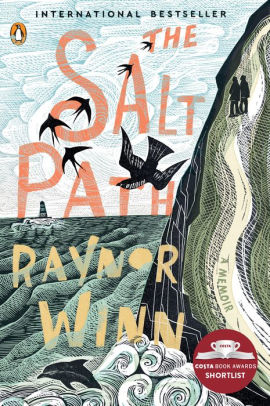
Continuing the search for water or sea stories, I found this. With a twist. That being that it’s about a couple that loses everything, so they have nothing more to lose when they set out on this salty journey.
The day after Raynor and Moth found out they were going to lose the Welsh farm where they had brought up their two children, a doctor tells Moth that he has a rare and incurable degenerative brain disease. Within days of this news, the bailiffs are knocking at their door and they are homeless.
With equal parts pluck and desperation, they embark on a journey to give them temporary purpose while trying to determine what to do next. They decide to walk the South West Coast Path, from Minehead in Somerset, through north Devon, Cornwall and south Devon, to Poole in Dorset, via Land’s End. A 630-mile walk.
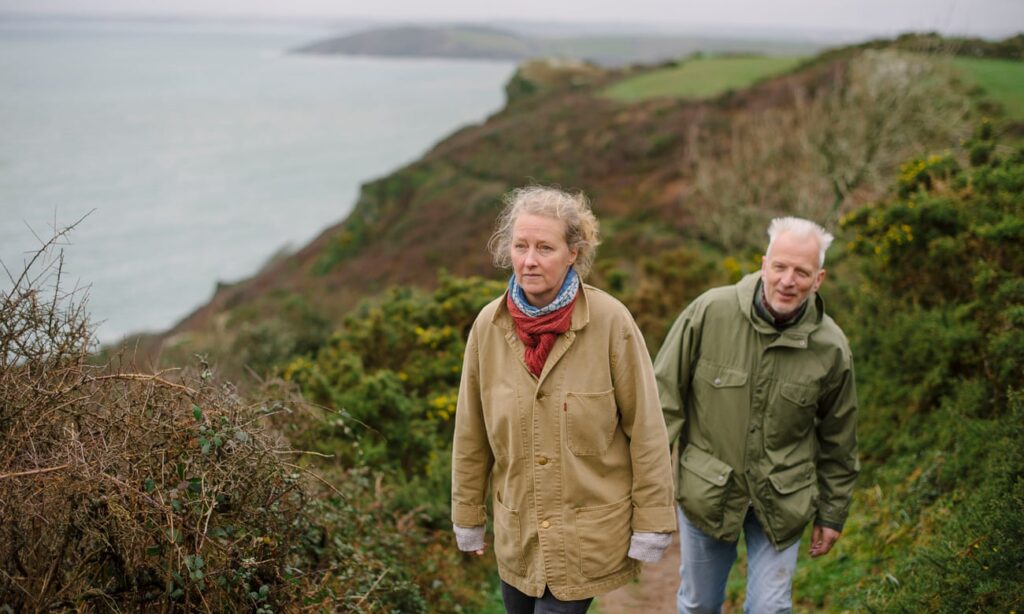
Their son is nonchalant, their daughter incredulous. “Are you mad?” she asks, as they set off with rucksacks and a copy of Heaney’s Beowulf, a book that plays a role in saving them along the way.
In struggling with their depth of loss and grief, their path is an emotional as much as physical journey of grace and grit. Including the often-grueling walking, cliff hanging sites for sleeping, days with little to eat aside from being raggedy old people with bird’s nest hair sleeping rough.
The upside is a rediscovery of their wild and free natures, the depth of their love for each other, moonlight swims, close encounters with bottlenose dolphins, a sense of the poetic, and lessons in hope: “Like the windblown trees along our route, we had been re-formed by the elements…I understood what homelessness had done for me. It had taken every material thing that I had and left me stripped bare, a blank page…”
Their openness to the journey freed them to reimagine their lives. And it’s the kindness of strangers that sets them on their continuing life path long after the walk has ended.
Sea Change: A Message of the Oceans by Sylvia A. Earle
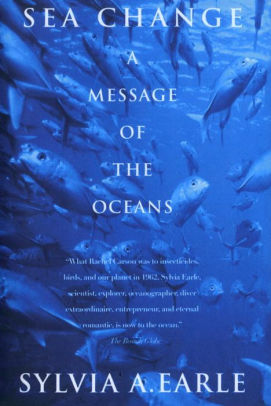
Sylvia Earle grew up experiencing the joy of swimming, and later underwater diving off the coast of Florida in the early 1950s. In this book, she recounts her odyssey as a marine biologist and as an educator in making the case for conserving oceans, including her role as chief scientist for the US National Oceanographic and Atmospheric Administration.
This book is an inspiring personal odyssey, and it’s also a persuasive argument for conserving marine resources.
Early in the book, Earle considers the question from a journalist who asks her why we should care about the sea. Earle’s response, that if we lose the sea, we lose all human life is the beginning of a longer explanation, and exploration, of the vital role of the oceans. The sea reaches 35,800 feet, equipment that can support marine explorers in the deep ocean is hugely expensive, and most governments and donors tend to support what’s known. Thus, “instead of applying 95% of our scientific efforts to 95% of the biosphere,” writes Earle, “most of the attention has been and still is focused on the brightly illuminated surface in which humankind normally functions–a dangerously cavalier bias, given the utter dependence of the 5% on the rest.” As Earle notes, less than one tenth of one percent of the deep sea has been explored.
In an early chapter, Earle recounts a conversation with congresswoman, playwright and ambassador, Clare Booth Luce, where Earle asks Luce why people feel more comfortable going to the moon or Mars than descending to the depths of the ocean. Luce responds and says she thinks it’s related to human culture more than human nature. “After all heaven is up there….and you know what’s in the other direction.”
Earle draws on her experience of more than 6,000 hours underwater to counter the ignorance that she believes is at the heart of many people’s indifference to the health of the sea. She peppers her book with stats and stories to make a powerful case for what’s needed. For instance, her story of taking her children out on a boat on San Salvador Island and their having an encounter with a wild dolphin locally known as Sandy:
‘The eldest, Elizabeth, blessed with a streaming mane of shining golden-red hair, was an irresistible lure. Approaching close and peppering her with rapid staccato sounds and soft, high weeeps, the dolphin mouthed locks of her hair, then eyes closed in a look of apparent bliss, gently let strands flow through his teeth as if trying to guess the nature of this intriguing silky substance. Gale, an elfin eight-year-old, was the only one of us petite enough to hitch a ride. Looping her small fingers along the leading edge of Sandy’s dorsal fin, she allowed herself to be towed in a circle around us, propulsion provided by thrusts of the dolphin’s muscular tail. It was a living reenactment of the dolphins and the cherubs depicted on ancient Roman coins and Greek mosaics.’
Twyla Tharp:The Creative Habit: Learn It and Use It for Life
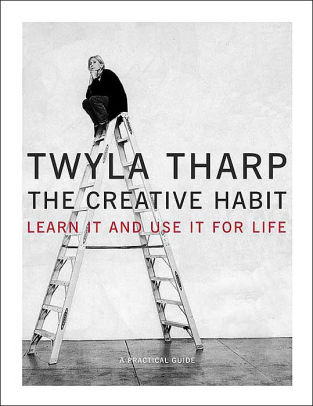
This is a great book in the tradition of Julia Cameron’s The Artists Way and Anne Lamott’s Bird by Bird in providing a creative structure through habit and ritual to fortify creativity. She speaks about the often-confronting process of starting with an empty room to design a new dance, or an empty page to write a new book.
As one of the world’s leading choreographers, dancers and creative leaders, Tharp accompanies her sharp insights on what sustains a creative life with thirty-two practical exercises to make it easy to begin. Again.
Black is the Body: Stories from my grandmother’s time, my mother’s time and mine by Emily Bernard

I discovered this book in a tiny bookshop in Putney, Vermont, where the owner made me an iced tea with a brew made by two poets turned tea makers. Nearby was a typewriter which tapped out text in cursive. Once home, I curled up with Bernard’s book and kept reading, fortified by toast with peanut butter, and grapefruit jelly made by one of the local farms in Vermont. These 12 interlocking stories that explore aspects of being black including growing up black in the South, teaching African American Studies, being married to a white man and adopting their two daughters from Ethiopia. Her starting piece for writing this collection is her recovery from a senseless knife attack which, in a profound way, frees her to use her voice and write these stories.
One of the stand-out stories (in a collection of stand-outs) is called “Teaching The N-Word,” where Bernard engages the 11 all white students in her African-American autobiography class at the University of Vermont on when, if ever, this word can be used. At one point during the discussion she invites her students to have the intellectual courage to criticize novels like Their Eyes Were Watching God and instructs them “not to confuse my body with the body of the book.”
In another story her white then-fiancé, John, the author, and her parents are driving to a family reunion in Mississippi when their car gets a flat tire. Bernard tells how John, who is driving, pulls over to change the tire while “There we stand — my black family, as vulnerable as an open window on a hot summer day.” Later, Bernard observes:
“John was not ignorant of the root of my father’s anxiety. But the danger presented by the flat tire took precedence over any other type of danger. Somewhere between the clarity of [John’s] focus and the complexity of my father’s anxiety, perhaps, lies the difference between living white and living black in America. … I see the difference. Mostly I despise it. But my belief that difference can engender pleasure as well as pain made it possible for me to marry a white man.”
One of the most affecting chapters for me is her exploration of adoption and how she’s often viewed as being different due to not giving birth to her daughters. “What I understand now is that the difference between pregnancy and motherhood is something like the difference between having an enormous wedding and being married.” Her writing opens a space for me to think about what it means to be a mother in the world rather than a mother to a specific child.
Bernard’s ability to hold contradictions and complexity in thinking about race while being a superb storyteller is compelling. As literary critic Maureen Corrigan, has said, ‘In Black Is the Body, Bernard proves herself to be a revelatory storyteller of race in America who can hold her own with some of those great writers she teaches.’